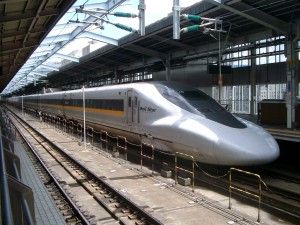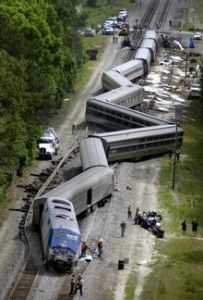Bullet train: Is L.A. Times’ beat reporter ashamed of edit page?
by CalWatchdog Staff | March 28, 2013 6:30 am
 March 28, 2013
March 28, 2013
By Chris Reed
There’s been quite a bit of good reporting done on the bullet-train fiasco. Mike Rosenberg of the San Jose Mercury-News and Lance Williams of California Watch jump to mind. But Ralph Vartabedian of the Los Angeles Times probably deserves top honors.
Vartabedian’s smart, nuanced beat reporting points discerning readers toward the truth — namely, that California’s project makes Boston’s Big Dig look like a work of efficient genius. The latest example was his piece this week on why and how some of the bullet train’s most ardent and longtime defenders have turned on the project[1]. It’s full of interesting specifics that set up his future reporting on court fights over the project’s legality.
But it’s more than just this sort of sharp professionalism. Bullet train followers know all about Quentin Kopp’s misgivings and the lies and deceptions that have marked the project since well before it won $9.95 billion in bond seed money from state voters in 2008. Here’s what Vartabedian has done that is exceptional: His reporting has shown the bullet train fiasco is even worse than we imagined!
This is from his Jan. 27, 2013, piece, headlined “State has yet to buy any land for train”:
“Construction of California’s high-speed rail network is supposed to start in just six months, but the state hasn’t acquired a single acre along the route and faces what officials are calling a challenging schedule to assemble hundreds of parcels needed in the Central Valley.
“The complexity of getting federal, state and local regulatory approvals for the massive $68-billion project has already pushed back the start of construction to July from late last year. Even with that additional time, however, the state is facing a risk of not having the property to start major construction work near Fresno as now planned. …
“It hopes to begin making purchase offers for land in the next several weeks. But that’s only the first step in a convoluted legal process that will give farmers, businesses and homeowners leverage to delay the project by weeks, if not months, and drive up sales prices, legal experts say.
“One major stumbling block could be valuing agricultural land in a region where prices have been soaring, raising property owners’ expectations far above what the state expects to pay. …
“Delays in starting construction could set in motion a chain reaction of problems that would jeopardize the politically and financially sensitive timetable for building the $6-billion first leg of the system. …
“If the construction schedule slips, costs could grow and leave the state without enough money to complete the entire first segment. ..
“In addition to property, the rail authority still needs permits from the Army Corps of Engineers and approval by the San Joaquin Valley Air Pollution Control District, two more potential choke points that Morales says can be navigated.
 [2]Here’s an excerpt from “Rail line’s big dig,” the Nov. 13, 2012, piece by Vartabedian that outlines the project’s insane complexity:
[2]Here’s an excerpt from “Rail line’s big dig,” the Nov. 13, 2012, piece by Vartabedian that outlines the project’s insane complexity:
“The sheer scale and scope of the bullet train’s push into Southern California, including traversing complex seismic hazards, would rival construction of the state’s massive freeway system, water transport networks and its port complexes. It is likely to be viewed in future decades as an engineering marvel — or a costly folly. ..
“The plan calls for bullet trains to shoot east from Bakersfield at 220 mph, climbing one of the steepest sustained high-speed rail inclines in the world. It would soar over canyons on viaducts as high as a 33-story skyscraper. The line would duck in and out of tunnels up to 500 feet below the rugged surface. It would cross more than half a dozen earthquake faults heading toward L.A.
“Tunneling machines as long as a football field will have to be jockeyed into mountain canyons to do the heavy, back-breaking work once left to Chinese laborers. New access roads and a corridor for high-voltage power lines will have to be carved through the Tehachapis to feed power-hungry trains. When completed and fully operational, the bullet train will need an estimated 2.7 million kilowatt hours of electricity each day — about a quarter of Hoover Dam’s average daily output. …
“One measure of the topographic challenge: Over that 141 miles from Bakersfield to Los Angeles, up to 59% of the track would run in tunnels or on viaducts, according to preliminary planning documents. …
“At this point, the rail authority estimates it will cost about $7.7 billion to build the 83 miles of rail from Bakersfield to Palmdale and about $12.5 billion to build the 58 miles of rail from Palmdale to Union Station. …
“Depending on the slope of the track, the tallest viaduct could be 200 to 330 feet off the ground.
“The same holds true for the segment through the San Gabriel Mountains, roughly following California 14. …
“California’s bullet train will have to operate over some of the nation’s most seismically active terrain … . There are half a dozen faults between Bakersfield and Los Angeles, including the White Wolf and San Andreas, both capable of producing a 7.5 magnitude quake. Where high viaducts are near faults, engineers are considering reinforced concrete structures that would resist ground motion and have containment features to prevent a derailed bullet train from plunging to the ground … . At full speed, however, a bullet train would need four to five miles to make an emergency stop on level ground, and longer going downhill.”
I don’t know how anyone could read this without thinking about every other sentence, “The state of California is competent to pull this off?” Nor do I think anyone could read this and think the bullet train will only cost $68 billion. Triple that — at least.
 Which brings us to the Los Angeles Times editorial page. According to Nexis, the last time it weighed in on the bullet train, in November 2011, here was the literally juvenile result:
Which brings us to the Los Angeles Times editorial page. According to Nexis, the last time it weighed in on the bullet train, in November 2011, here was the literally juvenile result:
“It’s a gamble, and not one to be taken lightly. But gasoline isn’t going to get any cheaper in the future and the freeways aren’t going to get less clogged. We think California can find a way to get the train built. We think it can. We think it can….”
Yes, the L.A. Times editorial page editor actually invoked “The Little Engine That Could” in sickeningly cutesy fashion to stick up for this folly.
I bet, to invoke a Trent Dilferism[3], Ralph Vartabedian threw up in his mouth a little when he read that painfully childish and uninformed editorial.
- have turned on the project: http://www.latimes.com/news/local/la-me-bullet-train-believers-20130323,0,6470905.story
- [Image]: http://www.calwatchdog.com/2012/09/13/will-gov-brown-kill-self-driving-cars-as-threat-to-bullet-train/train_wreck_num_2/
- Trent Dilferism: http://gawker.com/223220/
Source URL: https://calwatchdog.com/2013/03/28/bullet-train-is-l-a-times-beat-reporter-ashamed-of-edit-page/